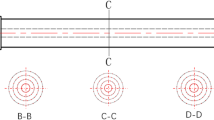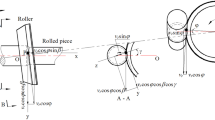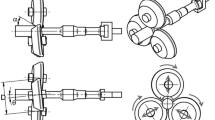Abstract
To optimize the wall thickness quality of three-roll skew rolling (TRSR) hollow axle, this paper explores the wall thickness quality from the perspective of forming mechanism and test design analysis. First, the finite element model of TRSR hollow axle was established based on SIMUFACT software. Second, the evolution characteristics of workpiece wall thickness under various initial wall thickness conditions were found by single factor test. Third, based on the metal flow velocity, the formation mechanism of wall thickness at different positions of the workpiece is discussed, and the causes of various wall thickness defects are found. Fourth, the wall thickness quality evaluation index was proposed and the orthogonal test was carried out. The relationship between process parameters and wall thickness quality was obtained. Fifth, a method of using irregular billets was proposed to improve wall thickness quality. The results indicate that the diversity of initial wall thickness of the workpiece can lead to two phenomena: wall thinning and wall thickening. A larger wall thickness will result in thinning of the wall thickness, while a smaller wall thickness will result in thickening of the wall thickness. The method of adjusting process parameters has limited impact on improving wall thickness quality. The method of using irregular billets can greatly improve the wall thickness quality of the hollow shaft.

















Similar content being viewed by others
Data availability
The authors confirm that the data supporting the findings of this study are available within the article.
References
Piwek V, Kuhfuss B, Moumi E, Hork M (2010) Light weight design of rotary swaged components and optimization of the swaging process. Int J Mater Form 3:845–848
Ghaei A, Taheri AK, Movahhedy MR (2006) A new upper bound solution for analysis of the radial forging process. Int J Mech Sci 48(11):1264–1272
Ghaei A, Movahhedy MR, Taheri AK (2005) Study of the effects of die geometry on deformation in the radial forging process. J Mater Process Technol 170(1-2):156–163
Sanjari M, Taheri AK, Ghaei A (2007) Prediction of neutral plane and effects of the process parameters in radial forging using an upper bound solution. J Mater Process Technol 186(1-3):147–153
Romanenko VP, Stepanov PP, Kriskovich SM (2018) Production of hollow railroad axles by screw piercing and radial forging. Metall 61(9-10):873–877
Bartnicki J, Pater Z (2005) Numerical simulation of three-rolls cross-wedge rolling of hollowed shaft. J Mater Process Technol 164:1154–1159
Urankar S, Lovell M, Morrow C, Li Q, Kawada K (2006) Establishment of failure conditions for the cross-wedge rolling of hollow shafts. J Mater Process Technol 177(1-3):545–549
Yang CP, Ma J, Hu Z (2017) Analysis and design of cross wedge rolling hollow axle sleeve with mandrel. J Mater Process Technol 239:346–358
Urankar S, Lovell M, Morrow C, Li Q, Kawada K (2006) Development of a critical friction model for cross wedge rolling hollow shafts. J Mater Process Technol 177(1-3):539–544
Pater Z, Tomczak J, Bulzak T (2015) Numerical analysis of the skew rolling process for rail axles. Arch Metall Mater 60(1):415–418
Pater Z, Tomczak J, Bulzak T (2015) Numerical analysis of the skew rolling process for main shafts. Metalurgija 54(4):627–630
Pater Z (2017) FEM analysis of loads and torque in a skew rolling process for producing axisymmetric parts. Arch Metall Mater 62(1):85–90
Zhang SH, Deng L, Che LZ (2022) An integrated model of rolling force for extra-thick plate by combining theoretical model and neural network model. J Manuf Processes 75:100–109
Rath S, Singh AP, Bhaskar U, Krishna B, Santra BK, Rai D, Neogi N (2010) Artificial neural network modeling for prediction of roll force during plate rolling process. Adv Manuf Processes 25(1-3):149–153
Zhang SH, Deng L, Zhang QY, Li QH, Hou JX (2019) Modeling of rolling force of ultra-heavy plate considering the influence of deformation penetration coefficient. Int J Mech Sci 159:373–381
Zhang SH, Che LZ, Liu XY (2021) Modelling of deformation resistance with big data and its application in the prediction of rolling force of thick plate. Math Probl Eng 2021:1–10
Tomczak J, Pater Z, Bulzak T, Lis K, Kusiak T, Sumorek A, Buczaj M (2021) Design and technological capabilities of a CNC skew rolling mill. Arch Civ Mech Eng 21(2):1–17
Pater Z, Tomczak J, Konrad L, Bulzak T, Shu XD (2020) Forming of rail car axles in a CNC skew rolling mill. Arch Civ Mech Eng 20(3):1–13
Pater Z, Tomczak J, Bulzak T (2020) Problems of forming stepped axles and shafts in a 3-roller skew rolling mill. J Mater Res Technol 9(5):10434–10446
Wang JT, Shu XD, Zhang S, Li SX, Pater Z, Xia YX, Bartnicki J (2021) Research on microstructure evolution of the three-roll skew rolling hollow axle. Int J Adv Manuf Technol 118(3-4):837–847
Lin LF, Wang BY, Zhou J, Shen JX (2021) Manufacturing large shafts by a novel flexible skew rolling process. Int J Adv Manuf Technol 118(9-10):2833–2851
Pang H, Ngaile G (2019) Development of a non-isothermal forging process for hollow power transmission shafts. J Manuf Processes 47:22–31
Huang X, Wang B, Mu Y, Shen J, Li J, Zhou J (2019) Investigation on the effect of mandrels on hollow shafts in cross-wedge rolling. Int J Adv Manuf Technol 102(1-4):1–13
Shen J, Wang B, Zhou J, Huang X, Li J (2019) Numerical and experimental research on cross wedge rolling hollow shafts with a variable inner diameter. Arch Civ Mech Eng 19(4):1497–1510
Zhang S, Shu XD, Wang JT, Xia YX (2020) Constitutive model of 30CrMoA steel with strain correction. Met 10(9):1214
Zuo W, Jiaqiang E, Liu X, Peng Q, Deng Y, Zhu H (2016) Orthogonal experimental design and fuzzy grey relational analysis for emitter efficiency of the micro-cylindrical combustor with a step. Appl Therm Eng 3:308–312
Zeiler A, Steinboeck A, Jochum M, Kugi A (2020) Model-based optimization of blade geometry in rolling-cut shearing to minimize common defects of the sheared edge. J Manuf Processes 52:213–219
Zhan M, Yang H, Guo J, Wang XX (2015) Review on hot spinning for difficult-to-deform lightweight metals. Trans Nonferrous Met Soc China 25(6):1732–1743
Funding
This study was supported by the National Natural Science Foundation of China (Grant Number: 51975301), the National Natural Science Foundation of China Youth Project (Grant Number: 52205403), the Natural Science Foundation of Zhejiang, China (Grant Number: LZ22E050002), and the Major Project of Science and Technology Innovation 2025 in Ningbo City, China (Grant Number: 2022Z064, 2022Z009, 2022Z015).
Author information
Authors and Affiliations
Contributions
Conceptualization: J.T. W. and X.D. S.; modeling and simulation: J.T. W. and C.Q. Y.; data analysis: J.T. W and Z.X. L; data interpretation: J.T. W and S.X. L.; experiment: J.T. W, Y. W, Y.M. D., and Q. C; writing—original draft preparation: J.T. W; writing—review and editing: X.D. S. and H.J. X. All authors read and approved the final manuscript.
Corresponding author
Ethics declarations
Ethics approval
This work does not include human and animal; hence, ethical approval from any committee is not required.
Consent to participate
This work does not include human and animal; hence, consent to participate in the research is not required.
Consent for publication
The authors give the publisher the consent to publish the work.
Conflict of interest
The authors declare no competing interests.
Additional information
Publisher’s note
Springer Nature remains neutral with regard to jurisdictional claims in published maps and institutional affiliations.
Jitai Wang is the first author.
Rights and permissions
Springer Nature or its licensor (e.g. a society or other partner) holds exclusive rights to this article under a publishing agreement with the author(s) or other rightsholder(s); author self-archiving of the accepted manuscript version of this article is solely governed by the terms of such publishing agreement and applicable law.
About this article
Cite this article
Wang, J., Shu, X., Ye, C. et al. Study on forming quality of three-roll skew rolling hollow axle. Int J Adv Manuf Technol 128, 1089–1100 (2023). https://doi.org/10.1007/s00170-023-11893-1
Received:
Accepted:
Published:
Issue Date:
DOI: https://doi.org/10.1007/s00170-023-11893-1




